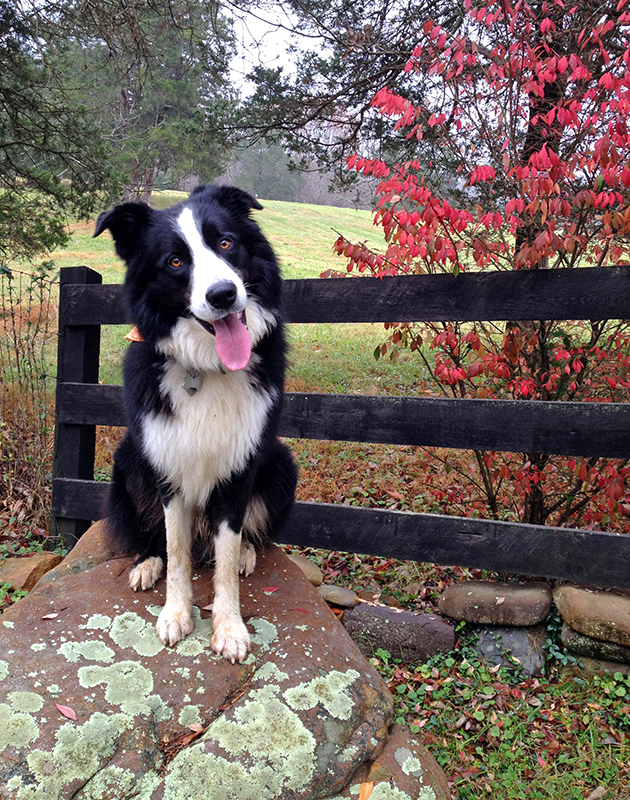January 24th, 2014 §
It was nine degrees here when I got home last night, and the week-old snow is still so dry and fluffy that it squeaks under my boots. I have the wood stove running nonstop to keep the auxiliary heat from engaging, especially after I just read that it costs 2-5 times the cost of the regular electric heat to run. And yet, when I called every Tractor Supply within a 100-mile radius I was told that their winter work gloves are all out of stock, and out of season.
Seriously? It doesn’t even take a calendar to know that we’ve still got at least two more months of winter glove-wearing weather ahead of us.

I got my Thinsulate-lined leather work gloves when I was living in Alaska, where the glove display at the local roughneck emporium took up an entire long wall. It’s really hard to find good gloves that fit a lady’s hand, well, like a glove, and I fell in love with this pair. They’ve become my favorite wood-splitting and stove-tending gloves, but I loved them a little hard last winter doing tree work. Now they’ve got a hole in the fingertip that’s rather inconvenient when tending a 600-degree chunk of metal.

I guess it’s time to go tan a hide and patch my gloves. Then hopefully next summer I will be able to buy a new pair of winter work gloves, because then, you know, they’ll be in season. I’ll wear them with my bikini.
January 22nd, 2014 §
Snowplows are rumbling outside my window, the white stuff’s still coming down, and temps are cold enough to warrant a red-light district in the chicken coop. Sounds like a great time to revisit England in July, this time to the Royal Botanic Gardens, Kew—a must-see spot on any gardener’s tour of England.
Kew was founded in 1759 and declared a UNESCO World Heritage Site in 2003. I thought that seemed pretty old until I looked up the world’s oldest botanical garden, which is in Padua, Italy and was created in 1545. The Padua garden is also a World Heritage Site, according the UNESCO, “considering that the Botanical Garden of Padua is the original of all botanical gardens throughout the world, and represents the birth of science, of scientific exchanges, and understanding of the relationship between nature and culture. It has made a profound contribution to the development of many modern scientific disciplines, notably botany, medicine, chemistry, ecology, and pharmacy.” Most people don’t immediately think of all these far-reaching implications of gardening, but there you have it, and it’s all true.
But that’s enough trivia—we came here to see Kew, and Padua will just have to join the very long list of gardens yet to be visited. In addition to being a top London tourist attraction, Kew is also a research institution for plant science and conservation. I can’t speak to any sort of research that’s happening at Kew, and can only appreciate it as a gardener. It’s definitely impressive, and huge, and though I’ve visited it twice on separate trips to England, I am sure there is still more to see. Far be it from me to cover it all in a couple of posts, so I will just focus on the areas most interesting to me.
In addition to giant, Victorian-era glasshouses that house palms and tropicals, there are a few more modern structures:

The structure above, to the left, is the newest glasshouse and one of my favorites. It’s the Davies Apline House, a rock garden full of all sorts of tiny little plants—most of them seeming Mediterranean in origin. I love how these small plants are basically served up on rocky platters, brought close for use to appreciate them in detail and in pleasing contrast to their rocky ledges. Can you believe that four full-time staff and one trainee are dedicated to the care of this glasshouse, which isn’t much larger than what you see in the photo? That is wonderful to me—so many talents and resources dedicated to such tiny plants in a little space.
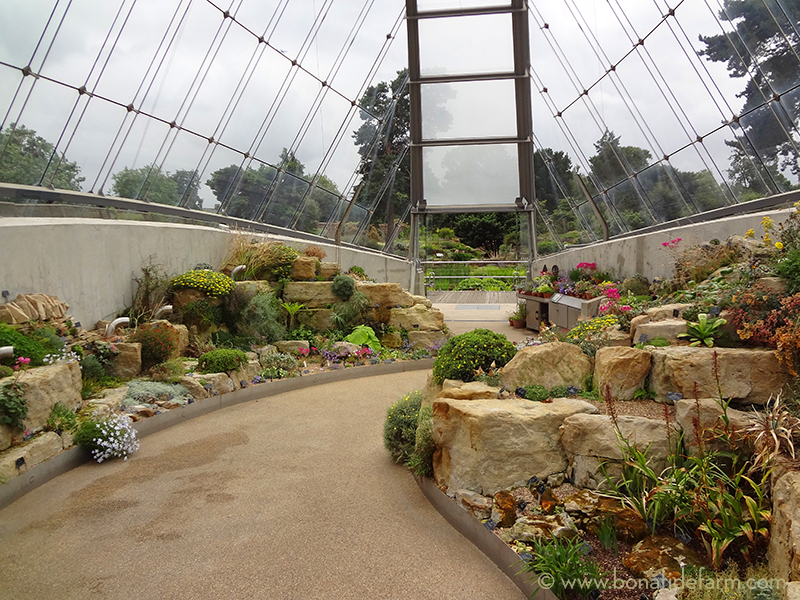
It was in this display that I found a spectacular oregano, Origanum amanum, from Turkey. It’s similar to a hybrid ornamental I grow in my own garden, Origanum “Kent Beauty.” The blue flower in the photo is some sort of bell flower.
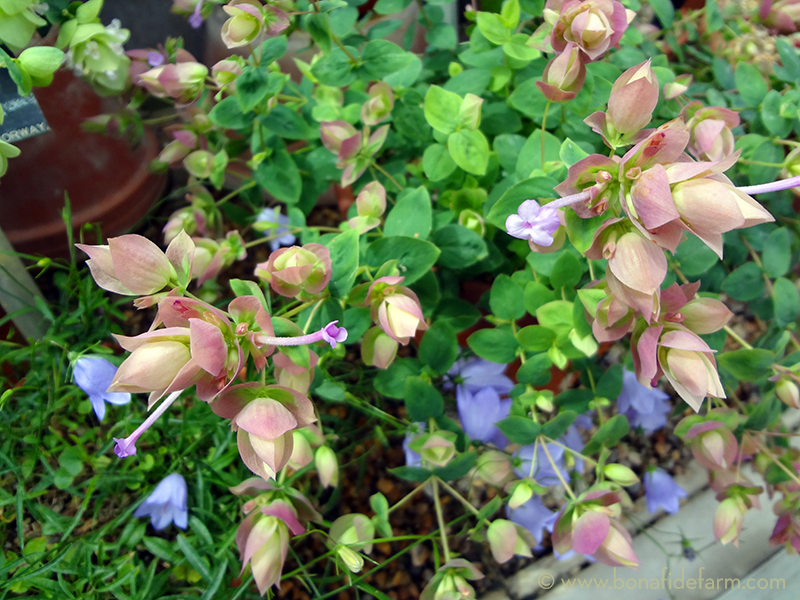
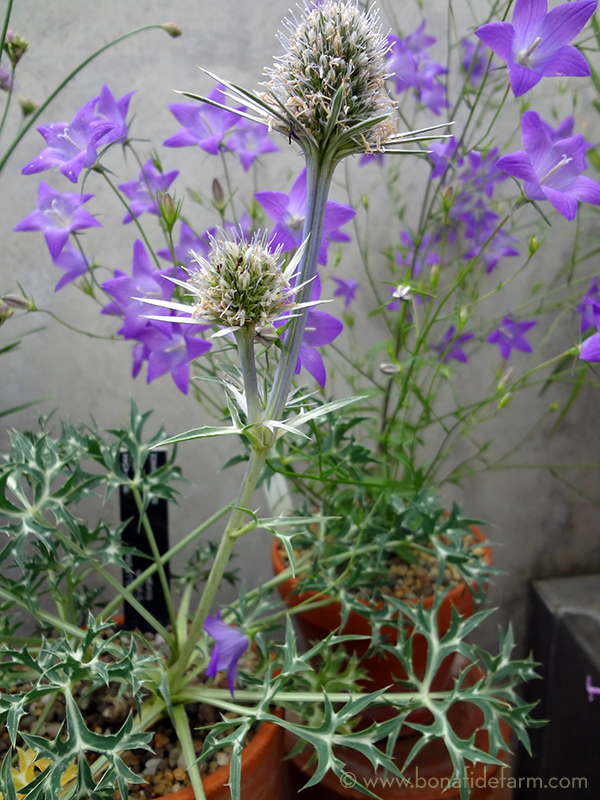
Just outside this glasshouse is an outdoor rock garden, which is one of my favorite areas of Kew. What I like about it, again, is how the rocks form a stage that elevate into the spotlight small and perhaps easily overlooked plants.
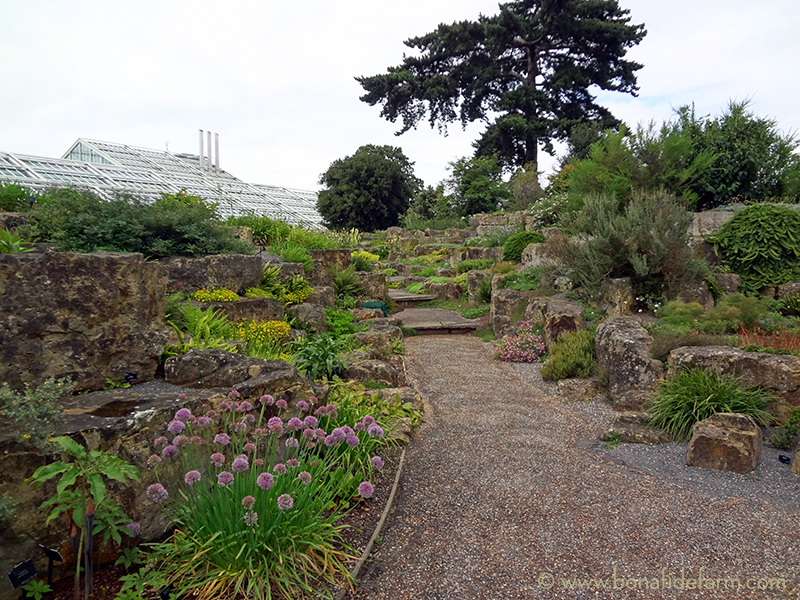
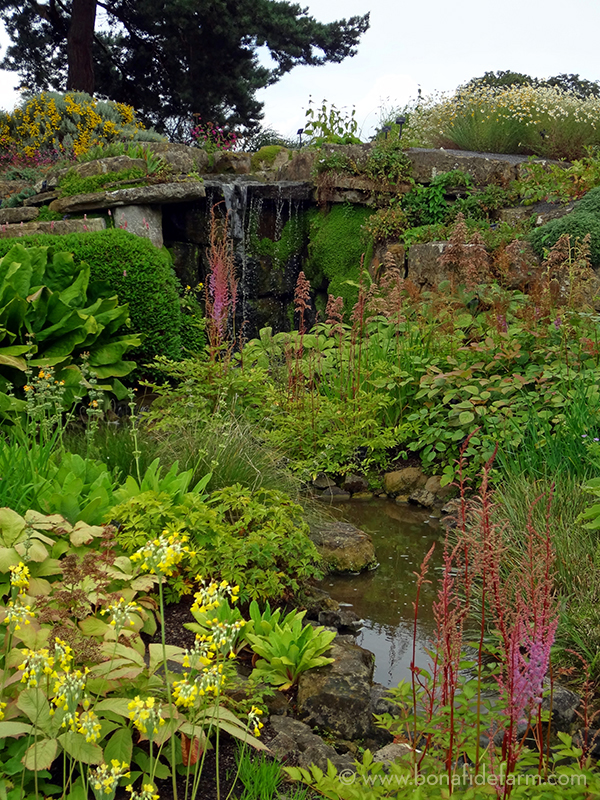
Near this area is a series of great meadows planted with all sorts of grasses. I love the painterly effect of their intermingling, and that they would be relatively low maintenance. This is definitely an idea I’d like to try somewhere on my own property—once I can get past the on-the-surface foolishness of replacing a perfectly good natural meadow with a cultivated one!
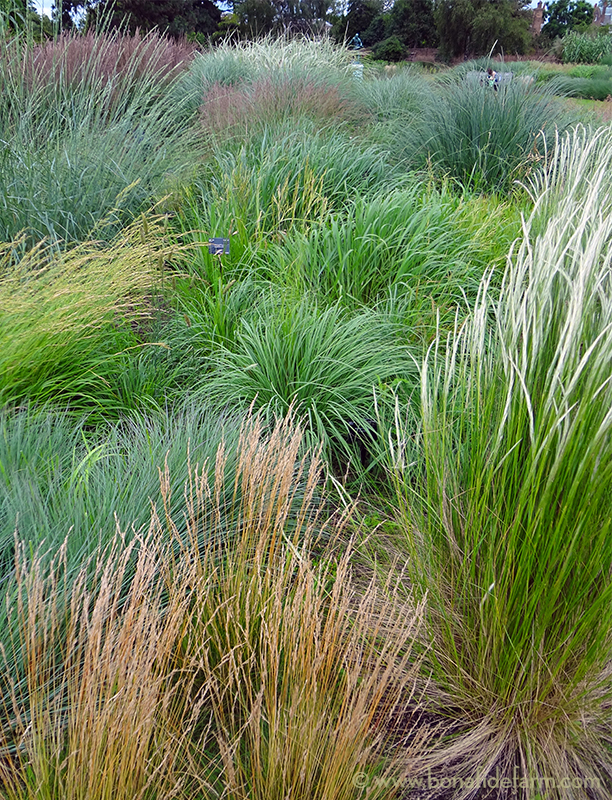
I won’t focus too much on the glasshouses, as I found them to be the least interesting part of Kew. They’re neat in that they’re old, and have lots of peeling-white-paint patina, but the plantings inside them just weren’t as interesting to me as what was going on outside. Perhaps that’s because I approach every garden visit with an eye toward what I can appropriate for Bonafide Farm, and a greenhouse full of tropicals just isn’t in my future. Although, funnily enough, my neighbors opened a winery centered on a giant greenhouse full of tropicals, so it’s certainly possible right in this mountainous little valley in Central Virginia.
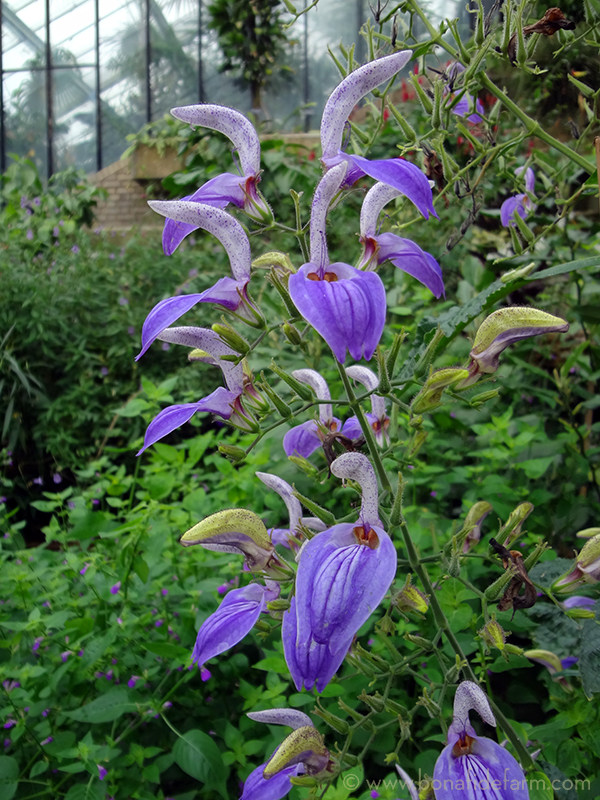
I couldn’t resist, however, this flowering vine growing in one of the glasshouses. I know not what it is, but isn’t it exquisite? If you can i.d. it, tell me in the comments, please!
Up next in part two, walking the grounds of Kew, and getting some wood with the sculptor David Nash.
January 20th, 2014 §
All that pottering in the garden yesterday was barely enough to keep me warm. To get the blood flowing I split some kindling, enough to get a few more wood stove fires going. I tore into a few rounds of of choke cherry cut this time last year when I cleared my wood line. It felt really good to split this beautiful red wood that I knew when it was still a living tree, festooned with honeysuckle and girded with wild brambles.
I was heavily supervised by the quality control team, which didn’t seem too perturbed when an errant piece of cherry clocked one of them in the head. That Griz (rooster, lower right) really keeps an eye on everything. He’s a personable rooster if I ever saw one—maybe because as an embryo he was rescued from a refrigerator and I held him in my hand within seconds of him kicking free of his eggshell?
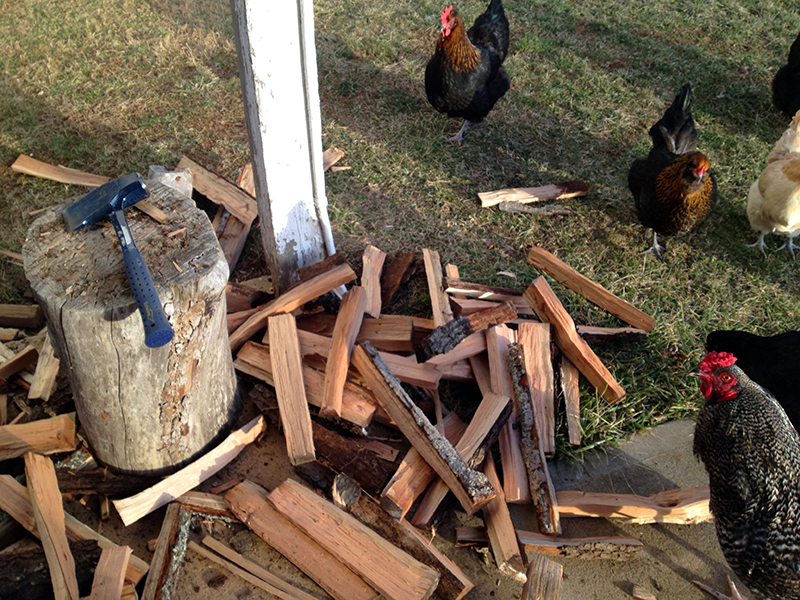
That makes me think of one of the most unexpectedly wonderful, and sometimes heartbreaking, aspects of this whole farm life. Whether it’s working to turn a living tree into fuel to heat my house or raising generations of homegrown chickens, it is beautiful to see cycles, and lifecycles, complete themselves under my watch.
I started stacking the kindling and this one, my English shadow, maneuvered himself right into portrait position and smiled for the camera with no direction from me. The Cora photobomb was similarly unscripted.

Speaking of Cora, she’s another country heard from with yesterday’s egg collection. Along with two small green eggs, and one large brown Dahlia egg, I found a pointy blue egg that could only have come from Cora. It’s one of less than ten that she’s ever laid in her life, which makes each of her eggs worth probably $100 when you figure in the cost of feed. If I hadn’t felt this little dear die and resurrect under my fingers, if I hadn’t become intimately acquainted with every muscle and vein of her skinless head as I fought to keep infection and fly infestation at bay, she would have long been Craigslisted by now.
But Cora still here, and once in a blue moon she lays a pointy turquoise egg. To my appreciation and great delight.
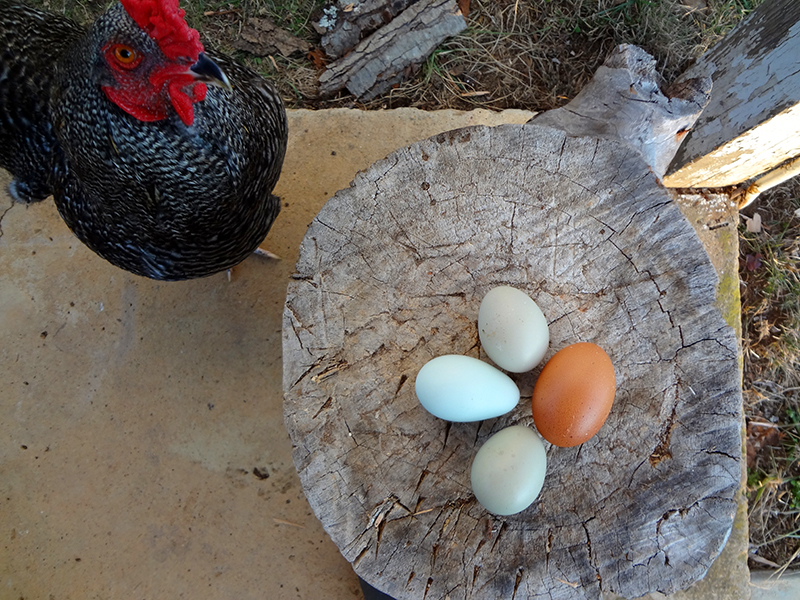
January 19th, 2014 §
“Gardening” is a bit of a stretch for what I did today as I walked the property, but it’s all I can do. With everything cold and sleeping, today’s tasks included checking staked trees for girdling and rodent attacks. I scraped a liquified but frozen dead mouse (mousesicle?) out of the crawlspace entry, and pruned still-more cicada damage out of the dogwoods. Most of my time was spent shoveling and sweeping the house garden’s mulch and compost back into place. The chickens are doing their winter thing, which is scratching in the loosest, most fertile and worm-filled soil of the acres they have access to—which happens to be in my garden. Of course. All this chicken activity exposes the prenatal tips of spring flowering bulbs, all pale and startled-looking to be so untimely unearthed.

So I go around and cover these little tips with compost and try to move and pat everything into place with reassurances: “Not quite yet, naked ladies, hold tight for a few more months and if any of those chickens take a nip, bite back.” Even as I tuck these shoots away it’s hard to contain my excitement that something’s happening under the dirt. Those promises sowed in November are halfway toward realization.
I’m itching to take the pruners to some of the standing dead perennial foliage that’s dragging the ground, but I learned my lesson last year when I lost track of where I’d planted certain things and smothered them under a new mulch application. So the stragglers stand, marking the location of my plants at least until I get the spring mulch down. I’m trying to view these dried-out sticks and seed heads through the naturalistic lens of some of my favorite garden designers, who design entire landscapes to be appreciated just like this in winter.
The best-looking thing in the garden right now is almost microscopic: my sedum. Sedum “Angelina” has taken on fantastic rainbow colors, and some unnamed small pink sedum is positively fluorescent.

It looks like the polar vortex of a couple weeks ago has already claimed some casualties. My Distylium “Blue Cascade,” which is being heavily marketed as an evergreen landscaping shrub suitable for zones 6b-9, is showing an aesthetically distressing but intellectually interesting pattern of winter burn that wasn’t there before we had our flirtation with zero degrees.
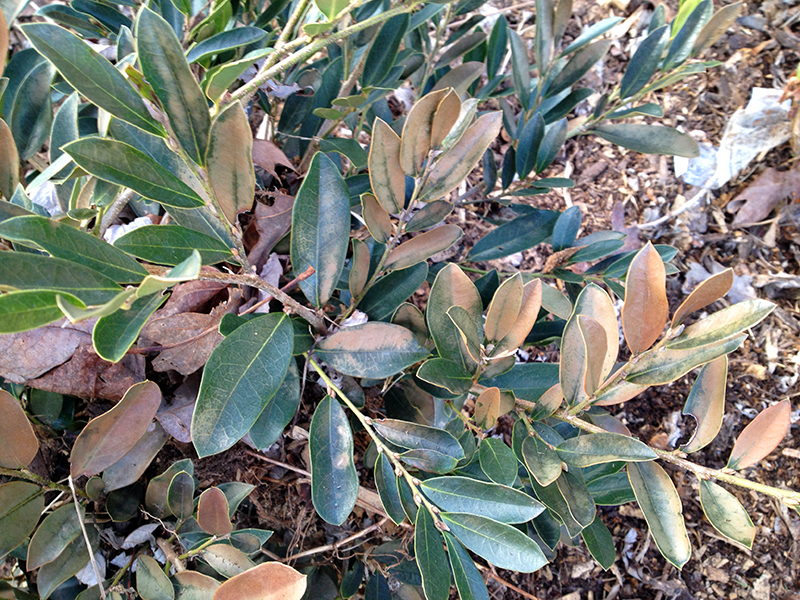
It will be interesting to see how it recovers—good thing I stuck just two of these shrubs in to trial instead of relying on them to carry an entire foundation planting.
And one of my two large clumps of rosemary decided that zero degrees just isn’t a Mediterranean climate, and it’s begun to brown out in a serious way.
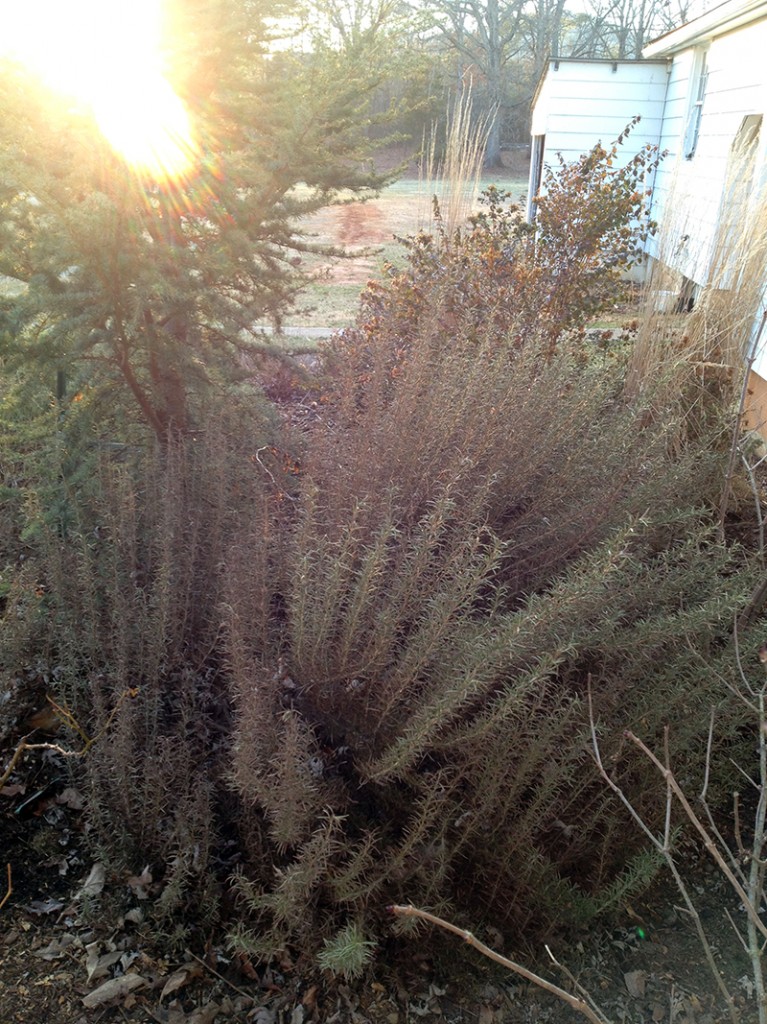
I admit that this big clump, which began as three smaller plants, wasn’t in peak form heading into winter. It had some sort of mite infestation that, while it wasn’t killing it, wasn’t exactly helping things. The interesting thing is that the other rosemary grouping, less than 20 feet away on the other side of the front walk with a similar exposure, evaded both the mite problem and the damaging effects of the polar vortex. Just like humans, plants with healthy immune systems are better able to withstand environmental stressors.
Is it sick to be excited to rip out the rosemary and have a nice big section to fill with something new? I didn’t ever plan for rosemary to become a foundation planting for me—I wasn’t expecting it to be winter hardy here—but it was (for a while!) and once it got big and took up space and stayed greenish through winter, I let it live. But now that it’s brownish, I have no compunction about pulling it all out come spring. As I’ve said before, I like taking things out of the garden more than I like putting things in. It’s a great feeling to give myself permission to correct course midstream, experiment, modify and adapt, and put new knowledge into practice through good editing.
January 17th, 2014 §
January 15th, 2014 §
We continue our tour of Bourton House by focusing on a few details. The image below is a good representation of what I just learned from Ursula Buchnan, in The English Garden, is the quintessential English garden: “informal and generous planting within a formal layout.” Such a simple definition but it cracked open a world of understanding for me. You can see the formal elements in the lawn bounded by paving blocks and in the wall at the far end of the path. But the plantings within this structure are riotous—they range and blend together and overspill their bounds onto the lawn.
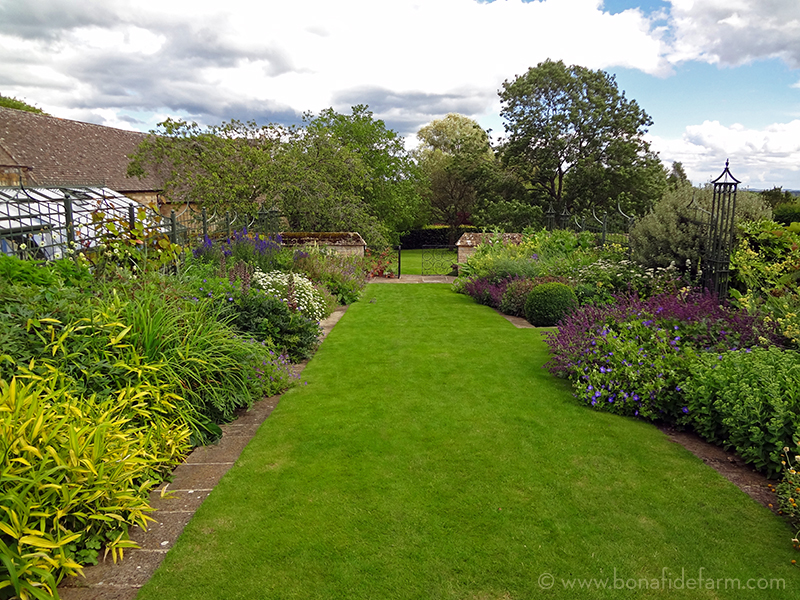
Even though they don’t fit the “English garden” definition as well as the photo above, I loved the areas in the two following photos. The collection of succulents and specimen plants looks like something I do at my own house, when all my tender plants go outside to spend the summer on the porch of the well house. I loved the succulents growing out of the wall, below, which gave the effect of the plants on the ground literally climbing the walls.
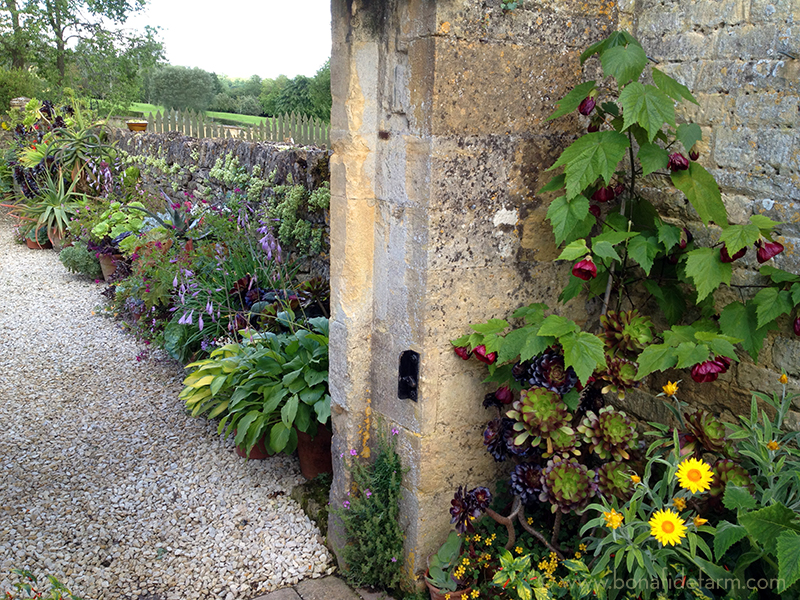
Someone with a great eye for color put this tiny masterpiece together. The shape of the geranium leaves (far right) really plays off the shape of the green and pink succulent in the center and makes for a unexpected and fascinating pairing.
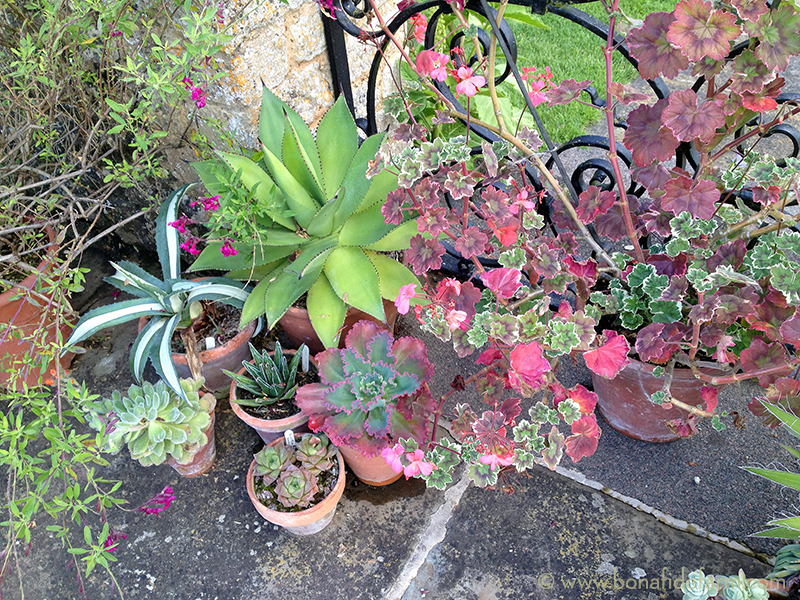
Next up, one of the coolest structures I’ve visited in England, the tithe barn adjoining Bourton House. It has a dedication stone of 1570 with the initials RP for the then owner, Richard Palmer. Back in the Middle Ages it was used to store the one-tenth of the farm’s produce that was tithed to the Church. What I loved about this space, which is now used as a gift shop and event space, was the proportions of the huge interior and the way the yellow Cotswold stone block walls joined to the plaster and beam ceiling. And look at these cross beams! They’re some seriously wonky, wormy, incredibly beautiful old wood.

The detail on the balcony railing was also particularly nice, with the wavy balusters. The finials were my favorite—hand-carved and crooked in a wonderful way that made them appear full of personality.
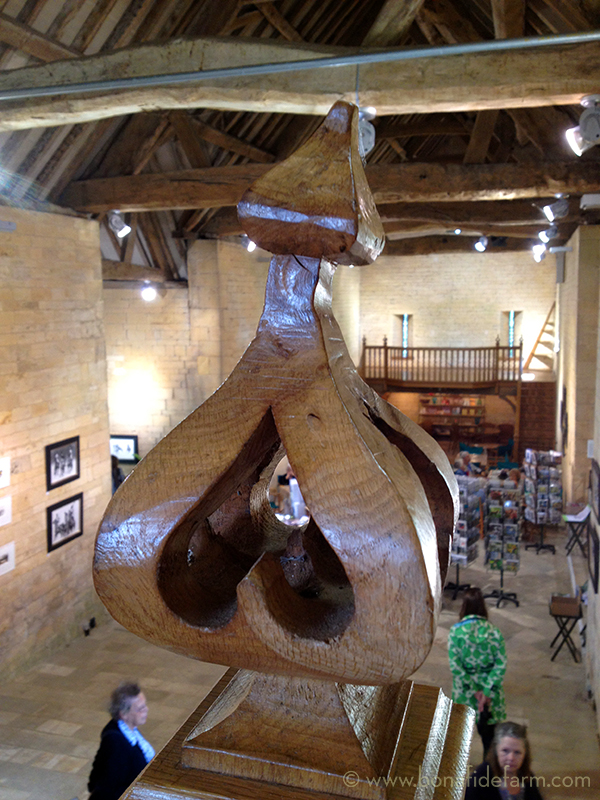
Back outside, I found the only topiary I’ve ever liked:
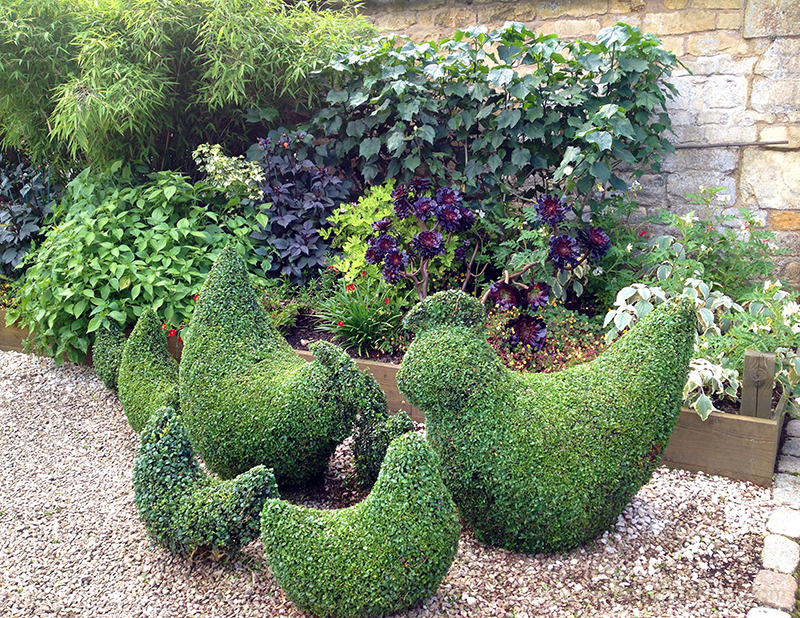
And finally, the mixed shrubbery planted along the exterior of the Bourton House fence is another master class in combining foliage colors.
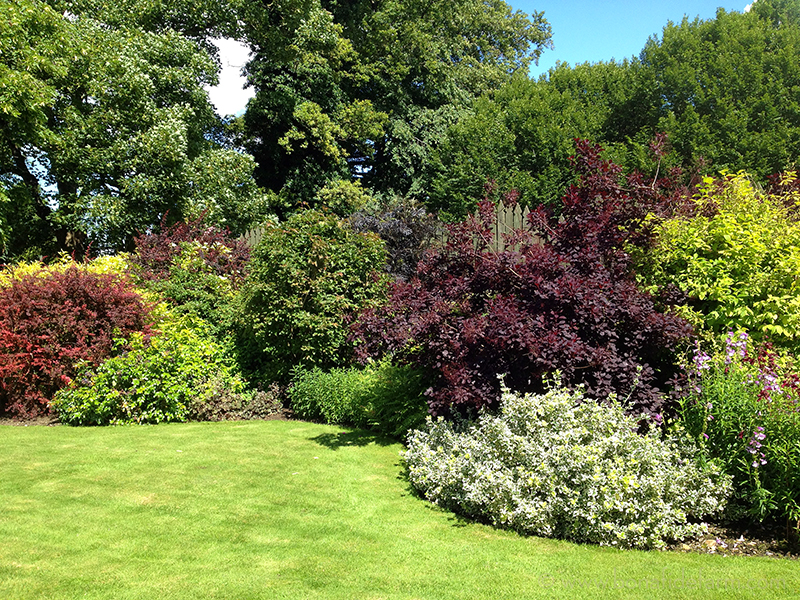
Some day, something like this is what I’ll do in the field between my house and my neighbors, in front of the screening trees that I planted a few years ago. At least this is the vision!
January 13th, 2014 §
It’s cold, dark and raining—you know, typical winter—and I’m seriously missing hours spent in the garden, not to mention the antidepressant effect of playing in the dirt. I really liked writing about the High Line a few weeks ago, and it made me realize that I have untold stories of other equally wonderful gardens. Because of that, and because nobody wants to read a post on how I’ve spent the last two days regrouting my shower, let’s get out of here and find something pretty with a short series on some of my favorite gardens that I’ve visited in the past few years.
First we’ll go to England and visit Bourton House, right in the beautiful Cotswold countryside near Morteon-in-Marsh. I stayed in this area for a couple of weeks in July, 2012, and took these photos then.
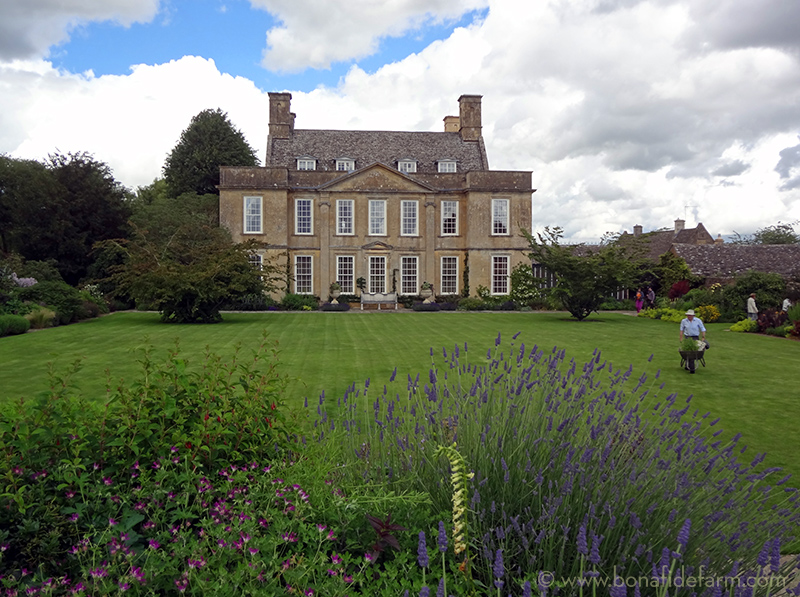
A bit of history from the Bourton House Web site:
Built on monastic lands, Bourton House and its Brewhouse, Stables and Coach House have created a courtyard since the late 16th century.
The house itself was rebuilt as a foursquare Jacobean house by the eminent lawyer, Sir Nicholas Overbury in 1598. At the beginning of the 18th century, the then unfashionable house was once again rebuilt on the earlier footprint by Alexander Popham, the grandson of a Cromwellian general. The house was taken down to its lower ground floor but the whimsical towers retained, the slits replaced by generous Georgian sash windows. The architect remains unknown. This setting has remained unchanged for three hundred years.
The lands originally belonging to the manor were sold in 1851 by Sir James Buller East MP, to the neighbouring Sezincote estate. Today Bourton House is surrounded by its immediate three-acre garden and a seven acre walled pasture, now given over to specimen trees and sculpture.
In 1953 the house and land were sold at auction and there followed a quick succession of owners, six to be exact, until 1983 when the house was acquired by Richard and Monique Paice.


The ornamental garden with its 18th century raised walk overlooking the rolling Cotswold hills; the original kitchen garden and orchard have been transformed in the past twenty five years. This achievement was recognised when Bourton House Garden received the prestigious HHA/Christie’s GARDEN OF THE YEAR (2006) award.
In 2010, the house was sold. The new owners have decided to keep the Garden open to the public with the active help of Head Gardener Paul Nicholls and Assistant Gardener Jacky Rae. Paul and Jacky have been responsible over many years for turning vision into reality and creating the wonderful garden seen today.
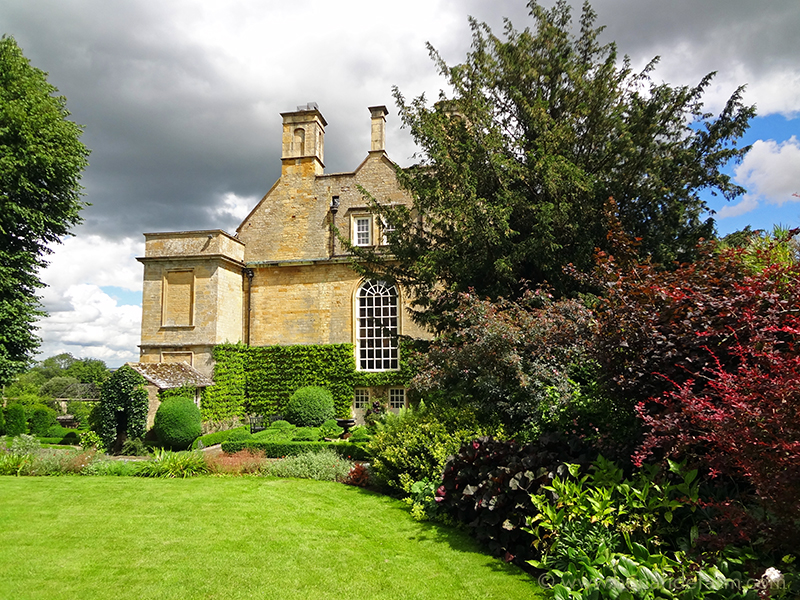
I was really impressed by the use of contrast in the Bourton House garden. As you can see in the two photos above, plants with dark foliage (dahlia and canna up above, and barberry and some other now-unidentifiable things below) are used to break up the swaths of pure green plants and grass. The dark plants create the effect of shadow even in full-sun exposures, and increase the visual depth of the borders.
The estate is surrounded by pastures filled with sheep and cows. It was lovely to hear their soft grazing noises while walking the grounds, and they’re very pretty lawn ornaments! Although I know firsthand that the day-to-day caretaking of livestock can often be the very opposite of bucolic, it was nice to dream a bit and aesthetically appreciate these animals without having to worry about their care.

I was impressed by how dynamic the clouds, sky and weather were in England during my visit. You can see in this series of photos, taken in just a couple hours, that the sun moved in and out from behind the clouds. Rain came and went as showers passed by. This made photographing fun and challenging, and the skies were never boring. It also made everything green, green, green! Just looking at these photos is already helping to alleviate my winter doldrums!
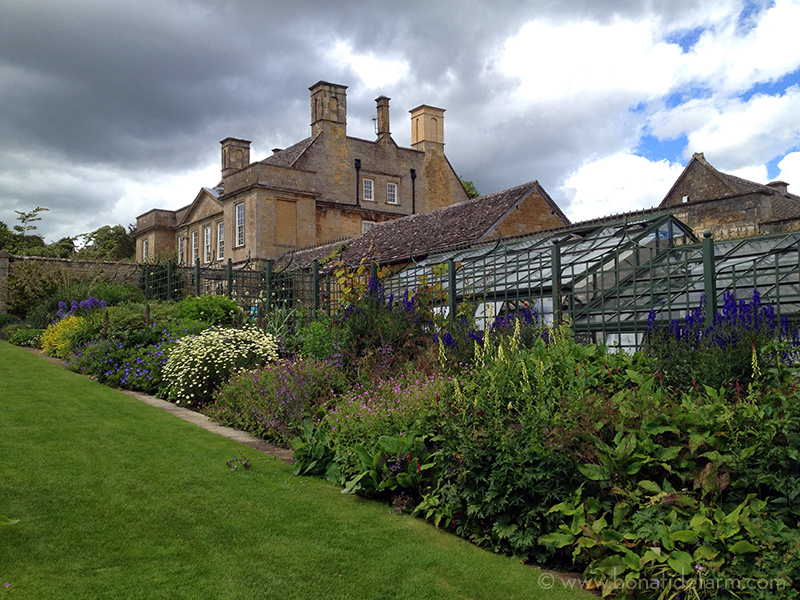
The beautiful glass house wasn’t full as it was high summer in England when I visited, but I can imagine how wonderful that space would be when used to start seedlings and extend the season into fall. Cold frames, below, are built up against the foundation of the glass house and are open to the sun. I love how the more modern glass house is incorporated into the ancient compound without it feeling intrusive or out of place. It’s a good lesson in proper scale and the wonderfully camouflaging properties of dark green paint.
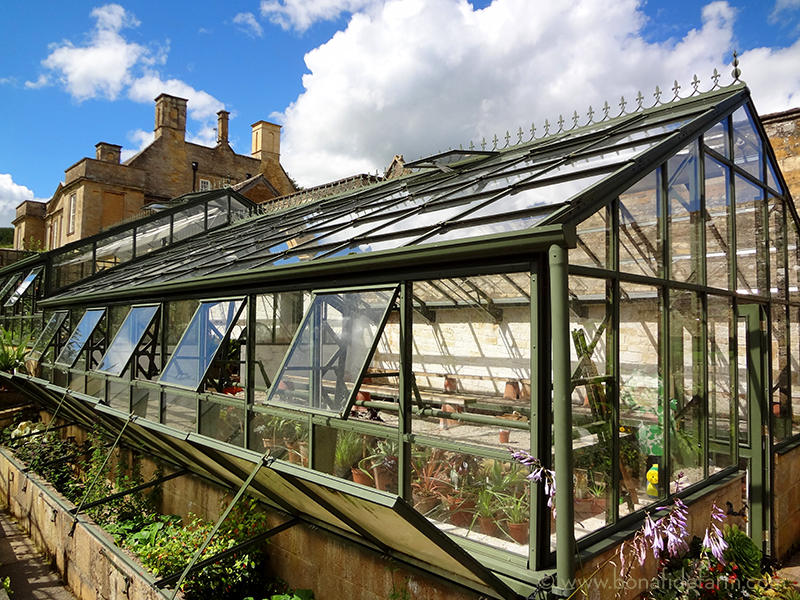
Up next: We examine the Bourton House garden in closer detail, and step inside a gorgeous 16th century tithe barn.
January 7th, 2014 §
Life in this already-small house has contracted to a few cozy square feet right in front of the wood stove as we wait for temperatures to warm. The gang’s all here, basking in the radiant glow of the beautiful Jotul.
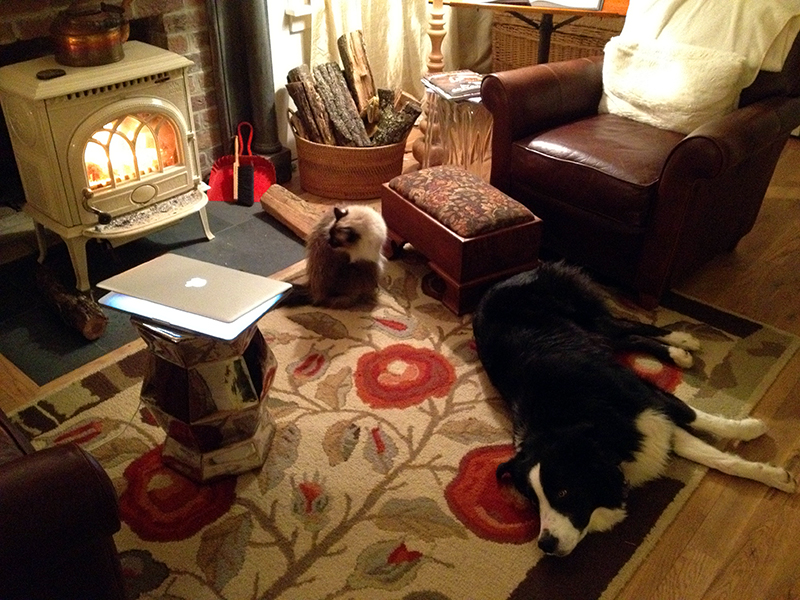
I shut off my heat pump last night to keep the expensive emergency electric heat from engaging, so we’re running on all-wood stove heat here. Keeping the stove going between 400 and 500 degrees today, and closing off the office and living room, has kept the temperature inside, in the main living area, at 65, which is the temperature I usually set the electric heat to during the day. I got up twice last night to feed the stove, and though it had burned down to large embers when I finally got up for good this morning, the house temperature had dropped to only 59 degrees in the main area. Even having no heat at all upstairs, the temperature on that floor is down to only 61. All perfectly acceptable temperatures for burning just a few armfuls of wood during the polar vortex, when, at 3:30 early this morning it was 2 degrees on my thermometer outside the kitchen window. In all I am again so pleased with my Jotul—one of my favorite, most functional, things in the world.
In times like these I really appreciate the compact layout of my house, with kitchen, wood stove, and a bathroom all within a few feet of each other. Everything I need is right here. It’s very easy to shut the doors to the guest bedroom, office and living room to contain the heat right in this area and funnel a bit of it up the stairs to the second floor. It’s actually a super-efficient design that, although I didn’t plan it to be, functions just beautifully in extreme weather events and power outages.
The chickens were fine last night. Even with their heat bulb on their gallon waterer froze solid. Once I had that defrosted they had “tea” this morning—warm water—at least until it freezes again! I’m leaving their heat light on tonight but after that temperatures will rebound and it’s back to normal winter and an unheated coop.
January 7th, 2014 §

The polar vortex arrived last night and brought with it sharply clear air that made the winter light even more intense than usual.
Speaking of light, the days are noticeably lengthening. It was still light enough to see the mountains’ silhouettes when I drove home at 6:00 p.m. Hooray!
January 6th, 2014 §
What a wonderfully evocative/apocalyptic name for this weather phenomenon affecting much of the U.S.! Central Virginia is being swirled into its embrace as I write. The temperature dropped 16 degrees in the last three hours, and the thermometer outside my kitchen window now reads 10 degrees at only 9:00 p.m.
This evening I turned on a red heat bulb in the chicken coop. As long as they have access to unfrozen water and plenty of food, chickens are just fine in low temperatures without supplemental heat—they snuggle close together on the roost and they are, after all, walking around wrapped in feather duvets. But with projected temperatures near zero with a wind chill warning, tonight I figured I would help them out a little bit by closing up their windows and heating their coop. It’s very rare that I use heat in the coop—in my climate it’s really not necessary.

If you’re considering heating a chicken coop with a light bulb, make sure the fixture is securely installed and not just precariously hanging. The risk of fire is too high otherwise. One of my friends burned down his garage when a light fixture he’d suspended over a broody box of chicks fell into their bedding. Imagine just how fast a wooden coop filled with pine shavings would go up in smoke should a lit heat bulb fall into the bedding. That would be one hell of a rotisserie!

I nailed my light fixture to a rafter and used cable clips to secure the extension cord that powers it to the walls, safe from being pulled down by either people and chickens. The set-up has worked great thus far, and even though I rarely use light or heat in the coop, it’s wonderful to have it there for these polar vortex situations! Which, by the way, and despite the howling winds, I am loving (from the warm coziness of my woodstove-heated snug little home). I have high hopes that all the ticks, squash bugs, harlequin bugs, bean beetles, etc. that plague my person, pets and garden will be totally obliterated in the next two days. A girl can dream!


















